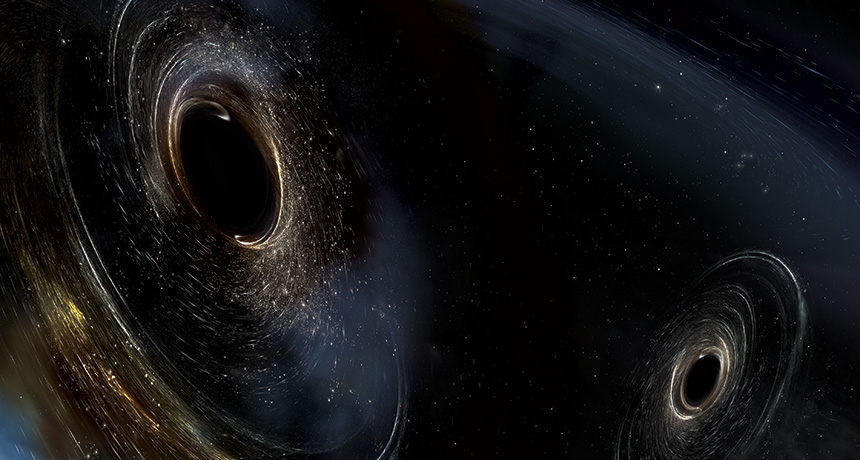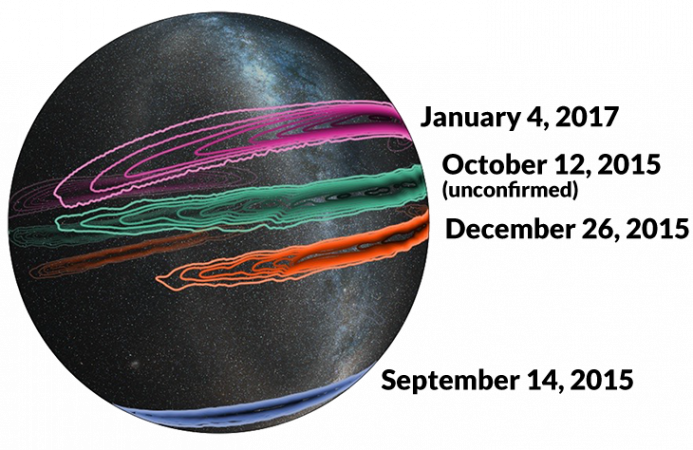Gravitational waves detected yet again
These spacetime vibrations were kicked up by a merger of black holes 3 billion light-years away

A pair of black holes, illustrated above, merge to become one in a powerful collision some 3 billion light-years from Earth. That smashup churned up newly detected ripples in spacetime.
Aurore Simonnet/Sonoma State, MIT, Caltech, LIGO
Long ago, some 3 billion light-years from Earth, two black holes orbited one another. In time, their gravitational tugs had them spiraling inward toward one another. Eventually, they embraced in a cataclysmic merger. The event fused them into one jumbo black hole. Its mass was about 49 times that of our sun. Moving across the universe at the speed of light, the wiggles this smashup imparted to spacetime finally reached Earth this past January 4. And a pair of incredibly sensitive twin instruments detected the teensy stretch and squeeze of space and time that they caused.
The pair of detectors are known as LIGO, for the Advanced Laser Interferometer Gravitational-Wave Observatory. Scientists described this gravity-wave discovery by LIGO on June 1 in Physical Review Letters. At a news conference one day earlier, the scientists heralded this, the third confirmation of gravity waves’ existence.
Gravity waves “are the most powerful astronomical events witnessed by human beings,” argues Michael Landry. He heads the LIGO observatory in Hanford, Wash.
In announcing this latest spotting of the elusive waves, Landry noted that the black-hole merger that spawned them had converted about two suns’ worth of mass into energy. That energy then radiated out across the cosmos in all directions as gravity waves.
A black hole likely starts as a collapsed star. Its mass all condenses into a space so densely stuffed with matter that its gravitational field also becomes enormous. Indeed, the gravity associated with a black hole is so strong that nothing — even light — can escape it. So a black hole isn’t actually a hole. It just appears to be empty space because no light can illuminate it.

LIGO’s two detectors, in Hanford and Livingston, La., each consist of a pair of 4-kilometer-long arms. They act as outrageously oversized rulers to measure the stretching of spacetime caused when gravity waves ripple by.
According to Einstein’s theory of gravity — the general theory of relativity — massive objects will bend the fabric of space. This will create ripples when they accelerate. That can happen, for instance, when two objects orbit one another.
These ripples are tiny: LIGO is tuned to detect waves that stretch and squeeze the arms by a thousandth of the diameter of a proton. Black hole collisions are one of the few events in the universe that are catastrophic enough to produce spacetime ripples big enough for people to detect from a great distance.
The black holes that spawned the latest waves were particularly hefty. One had a mass about 31 times that of our sun. The other had about 19 times the sun’s mass. LIGO’s first detection of gravity waves, announced 16 months ago, came from an even bigger duo: colliding black holes 36 and 29 times the mass of the sun. LIGO’s second detection featured two smaller black holes, 14 and eight times the mass of the sun.
Ligo sightings
LIGO’s three sightings of gravity waves, thus far, have all been spawned by merging black holes. But those mergers varied in mass, distance and the energy released as gravitational waves.
| First detection | |
| Date: | September 14, 2015 |
| Mass of first black hole: | 36.2 solar masses |
| Mass of second black hole: | 29.1 solar masses |
| Merged mass: | 62.3 solar masses |
| Energy radiated as gravitational waves: | 3 solar masses |
| Distance from Earth: | 1.4 billion light-years |
| Second detection | |
| Date: | December 26, 2015 |
| Mass of first black hole: | 14.2 solar masses |
| Mass of second black hole: | 7.5 solar masses |
| Merged mass: | 20.8 solar masses |
| Energy radiated as gravitational waves: | 1 solar mass |
| Distance from Earth: | 1.4 billion light-years |
| Third detection | |
| Date: | January 4, 2017 |
| Mass of first black hole: | 31.2 solar masses |
| Mass of second black hole: | 19.4 solar masses |
| Merged mass: | 48.7 solar masses |
| Energy radiated as gravitational waves: | 2 solar masses |
| Distance from Earth: | 2.9 billion light-years |
Weighty black holes are difficult to explain. The reason: The stars that collapsed to form them must have been even more massive. Typically, stellar winds steadily blow away mass as a star ages. This can lead to a small black hole. But under certain conditions, those winds might be weak. For example, the stars might contain few elements heavier than helium or have intense magnetic fields. The large masses of LIGO’s black holes suggest that they formed in such environments.
Clearly, astrophysicists don’t fully understand how such big black holes form. But now, “it seems that these are not so uncommon,” says physicist Clifford Will. “So clearly there’s a way to produce these massive black holes.” Will works at the University of Florida in Gainesville.
Scientists also disagree about how black holes partner up. One theory is that two neighboring stars each explode and produce two black holes, which then spiral inward. Another is that black holes find one another within a dense cluster of stars, as massive black holes sink to the center of the clump.
The new detection of gravity waves provides some support for the star-cluster theory. The wave pattern that LIGO observed hints that one of the black holes might be spinning in the opposite direction of its orbit. Like a cosmic dance, each black hole in a pair twirls on its own axis as it spirals inward. Black holes that pair up as stars are likely to have their spins aligned with their orbits. But if the black holes instead find one another in the chaos of a star cluster, they could spin any which way. That’s what LIGO appears to have seen. But that interpretation is “not definite,” says Avi Loeb. An astrophysicist, he works at Harvard University in Cambridge, Mass.
Scientists will need more data to sort out how the black hole pairs form, agrees physicist Emanuele Berti. He works at the University of Mississippi in Oxford. It’s likely, he says, that various processes contribute to these pairings.
Having seen evidence of three black hole mergers, scientists are looking forward to a future in which gravity-wave detections become routine. The more waves detected, the better scientists can test theories of what creates them and how. “There are already surprises that make people stop and revisit some old ideas,” Will says. “To me that’s very exciting.”
NOTE: This story has been corrected for a transciption error in the “Third detection” table in the original version. The solar masses for merged mass and energy radiated as gravity waves had been inadvertantly swapped.







